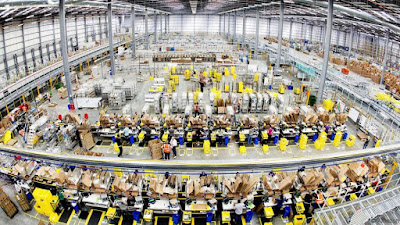 |
| Amazon's vast, 40,000 sq m, fulfilment centre in Hemel Hempstead (Credit: Amazon) |
By Chris Baraniuk, 18 August 2015
When you click “buy’ on Amazon, a flurry of activity begins inside a nearby warehouse – all managed by smart computer code. What’s it like to work there?
“Work Hard. Have Fun. Make History.” So reads a sign above the entrance to Amazon’s newest UK “fulfilment centre” (or warehouse) in Hemel Hempstead.
Inside lies more than 40,000 sq m of shelving, packing lines and millions of products. One area where larger products are stored is known as “pallet land” and adjacent, at another end of the space sits “the tower”, where several floors of shelving are stacked on top of each other. Pickers constantly, and more or less silently, walk up and down the tower’s lengthy aisles, pushing carts into which they deposit items purchased by someone, somewhere online.
Founded at the dawn of the web in 1994, Amazon is now reportedly worth $247bn (£157bn). But the company is not, in fact, hugely profitable. What keeps Amazon afloat? As for any business with tight margins, efficiency is key.
A recent New York Times investigation revealed that the corporate culture inside Amazon is highly driven by data: personal performance, for example, is continually checked with a software system called the Anytime Feedback Tool that allows employees to share praise or criticism about their colleagues.
At the company’s warehouses, the workers are also guided and monitored by software, but in a much more direct way. When you order an item online, the Amazon system quickly works out where the item sits in its inventory, and dispatches a human picker to go fetch it. “It’s not about learning where things are, in your head, or having to memorise,” explains general manager Henry Low. “We make the task as simple as possible.”
One of the first things that strikes you about the Amazon fulfilment centres is that the products aren’t organised logically – or at least in the kind of fashion that a human would use. For instance, products on shelves are not organised by category. Instead, they are placed on shelves as if by random. An HDMI cable lies near to five copies of some Harry Potter sheet music. A brand of baby’s bottle is across the aisle from a drain water diverter. But there is method to this apparent madness. “Imagine picking one model of HDMI cable from a shelf of hundreds of them,” says Low. The pickers are not meant to have to think too long about what they’re retrieving – the whole process is designed to be as streamlined as humanly possible.
 |
| Preparing for Christmas in Peterborough, Cambridgeshire (Credit: Rex) |
The BBC’s Panorama programme has reported in the past on the high levels of accuracy and productivity expected of employees in Amazon warehouses. Reportedly, the pickers’ handheld devices in some warehouses count down the seconds that they have to retrieve the next product, in order to meet their performance targets.
 |
| Scanners instruct the pickers where to go, and reportedly count down in seconds how long it should take (Credit: Rex) |
Thomas Owens, a picker at the centre estimates that he picks, on average, 1,000 items a day. “It depends on what process path you’re doing. But between break-times it’s normally between 200 and 300, so I’d say it’s about 1,000 or 1,200 a day,” he explains. In a 10-hour shift, that equates to almost two items every minute. Still, Owens adds that missing a handful of these countdowns is perfectly acceptable, and does not prevent pickers from meeting their overall productivity targets.
 |
| Workers in Peterborough prepare for 'Cyber Monday', the busiest online shopping day of the year (Credit: Rex) |
Another company, called Sick, has invented sophisticated sensing equipment that can be used in highly automated warehouses. Human eyes may be less and less useful in the future since, as a company press release about a visual sensor boasts, “the Sick Inspector P30 […] enables the automated crane system to pick and place more quickly, saving typically 10 seconds per pick (potentially 15% extra picking cycles per hour).”
 |
| Pickers, here at Peterborough, wander the shelves almost silently (Credit: Rex) |
Several rows of workers tasked with this part of the process are busily filling boxes, keeping packages moving onto conveyor belts at a steady pace. Later, of course, these packages will be driven to homes and businesses up and down the country by human drivers for delivery. Still, with Amazon now experimenting with the idea of delivery-by-drone, it’s not clear for how long exactly that part of the chain will go unmodified.
 |
| Items on shelves are not organised logically, by category, but seemingly at random (Credit: Rex) |
“Work Hard,” said the sign near the entrance. On the warehouse floor, it’s apparent that the largely anonymous people who handle your online purchases take the first part of this mantra seriously.
 |
| Amazon's software tracks progress of your item delivery at every stage (Credit: Getty Images) |
 |
| Workers often collect more than 1,000 items per day (Credit: Rex) |
